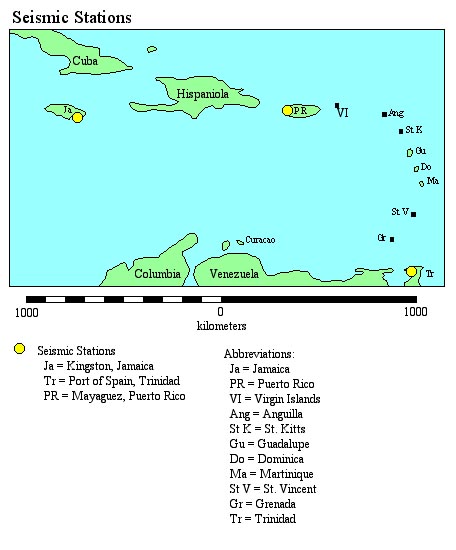

In this section of the exercise you will analyses three seismic records of an earthquake. The purpose is to determine (1) when the earthquake occured, (2) where the epicenter is located, (3) the magnitude of the earthquake, and (4) the specific cause of the earthquake. Below you will find three seismograms for the earthquake. The first seismic station is in Kingston, Jamaica, the second station is in Mayaguez, Puerto Rico, and the third station is in Port of Spain, Trinidad. The arrival time of the P-wave is given on each of the seismograms, and is also given on your answer sheet.
For each seismogram measure the S-P interval and the amplitude. Enter the values on your answer sheet.
Seismogram #1

On your answer sheet record the following measurements:
Arrival time of the P-wave.
S-P interval (seconds).
Amplitude (mm).

Arrival time of the P-wave.
S-P interval (seconds).
Amplitude (mm).

Arrival time of the P-wave.
S-P interval (seconds).
Amplitude (mm).
Now, for each seismic station determine the distance to the epicenter using the following graph. The red line shows how the S-P interval relates to the distance to the epicenter. For each seismic station, find the S-P interval time on the vertical scale, move across horizontally to the red line, then vertically down to the distance scale, and record the distance on your answer sheet. Now, for the same distance move vertically up to the line labelled "Travel time P-wave," then horizontally to the left, back to the time scale, and record the P-wave travel time on your answer sheet.

When did the earthquake occur? You can determine this by subtracting the travel time of the P-wave from the arrival time of the P-wave. Do this for each seismic record, and enter the times on your answer sheet.
T(0) = (P-wave arrival time) - (P-wave travel time)
The next step is to determine the Richter magnitude. This can only be done for seismograms that did not go off-scale. For each seismogram, use the following nomogram to estimate the magnitude. Do your work on the copy of the nomogram on the answer sheet. For each seismogram mark the distance to the epicenter on the left scale and mark the amplitude on the right scale. Connect the distance and the amplitude with a straight line. Where the line intersect the middle scale gives the magnitude. Do this for each of the seismograms, for three estimates of the magnitude. Enter the values on your answer sheet.


2.1 What's your best estimate for T(0), the time that the earthquake occured at the epicenter?
2.2 What's your best estimate for the magnitude of the earthquake?
2.3 Where is the epicenter? Describe the location.
2.4 Is the epicenter in an area with a history of earthquakes?
2.5 What do you suppose caused the earthquake? (Be specific.)